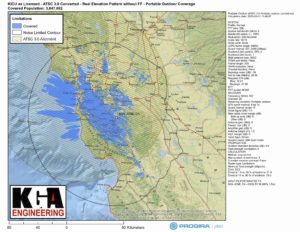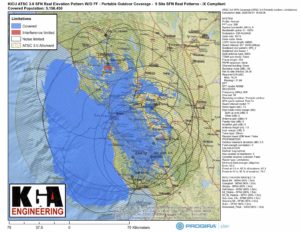PROGIRA® plan software unleashes new revenue streams for Kessler and Gehman Associates
Broadcast industry consultant finds value in software for sfn planning
BALTIMORE, April 9, 2020 – Acrodyne Services continues to see interest from the US consultant community for its PROGIRA® plan broadcast network planning software as ATSC 3.0 planning accelerates for NextGen TV. Broadcast industry consultant Kessler and Gehman Associates (KGA) is one customer that is seeing a quick return on investment as more US broadcasters strategize their NextGen TV futures.

PROGIRA® plan is a powerful tool used worldwide to help consultants and their end customers design broadcast TV networks for optimum reception probability, a significant improvement over other planning solutions that only address field strength predictions. In recent months, Acrodyne has seen increased US sales as broadcasters move past repack and begin planning their ATSC 3.0 deployments. It is widely expected that many of these systems will take advantage of the OFDM foundation of ATSC 3.0 to transmit content using single-frequency networks (SFNs) that position multiple lower-power transmission sites around a market. That is a stark change from the typical tall tower, high power ATSC 1.0 TV systems that are designed using simpler coverage predictions.
“ATSC 1.0 was planned using long-established methods for a single use case – the tall tower, high power system. The modeling assumed directional rooftop antennas were used throughout an entire broadcast market, and field strength predicted to be above minimum threshold meant that coverage was achieved, which was clearly not true in practice.” said Andy Whiteside, General Manager of Acrodyne Services and President of Dielectric. “NextGen TV opens up a broader set of reception options that cover fixed and mobile systems. The ATSC 3.0 standard’s enabling of SFNs makes content delivery to these systems possible although predicting reception is far more challenging, requiring the use of a powerful modeling toolset.”
Whiteside points out that broadcasters are deploying NextGen TV in conventional tall tower, high power systems as well as SFN systems. PROGIRA® plan allows prediction of reception in both deployment methods for the wide variety of modulation and coding options the new standard permits. Consultants like KGA have increasingly turned to PROGIRA® plan and its sophisticated analysis toolset for ATSC 3.0 SFN planning. PROGIRA® plan helps consultants plan networks with multiple transmitter sites that are carefully designed to reinforce each other for consistent market-wide reception, whileavoiding self-interference. The software also helps users understand reception conditions and network timing requirements for mobile viewers. This is a key value proposition of NextGenTV, since the 6MHz channel can contain multiple PLPs (Physical Layer Pipes) chosen and coded for different reception environments.
“We purchased PROGIRA® plan for a variety of projects around spectrum planning and optimization, but there’s no question that the main scope is for ATSC 3.0,” said Ryan Wilhour, Consulting Engineer at Kessler and Gehman Associates.“The main benefit is the amount of time we save in planning SFN sites. The software interfaces with the FCC LMS database and exports studies to TV Study for final FCC presentation. It automatically defines the appropriate antenna patterns and network timings. We no longer have to manually pull in antenna patterns, apply them to contours one by one, and evaluate if they remain within allotted coverage areas. The software integrates seamlessly with ArcMap geographic information systems (GIS) as well, and allows me to very quickly generate contours and their population counts. Other tools I have used are very limited when it comes to integration with professional GIS programs.”

Wilhour points to an SFN project in San Francisco that is modeling potential reception plans for several UHF TV channels. According to Wilhour, working closely with Dielectric for new antenna designs, the PROGIRA® plan software helps him thoroughly analyze coverage contours around the entire market, and carefully exclude populations that lie just outside of each boundary. That exacting precision returns a substantial amount of time to the KGA team that they can then devote to other projects. Beyond SFN planning, Wilhour is using PROGIRA® plan for other broadcast projects, including a studio-to-transmission microwave path profile for an existing ATSC 1.0 system.
KGA is also experiencing a quick ROI on their purchase, as PROGIRA® plan has delivered a revenue-generating benefit. “There is no question that we are finding new business and making money by using this software,” said Wilhour. “We have one client that is looking at ATSC 3.0 SFN plans for all major markets, and they understand the requirement for accurate coverage models. We can start with the basic metric analysis and then provide very detailed theoretical data that will help them accelerate network buildouts, from identifying proper antenna patterns to gaining construction permits. This software opens up many new business opportunities.”
About Acrodyne Services
Acrodyne Services, a wholly owned subsidiary of Sinclair, provides service and support for Broadcast transmitters throughout the world. This includes the large installed base of transmitters sold by Acrodyne Industries (Ai) over its 40-year history, as well as products manufactured by Rohde & Schwarz, Harris, Comark and others. The staff of Acrodyne Services offer a combined total of over 150 years of experience in the design, manufacture, installation and support of all types of TV transmitters. www.acrodyneservices.com.